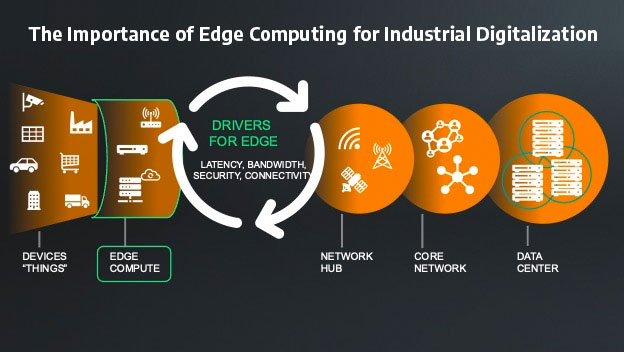Manufacturing organizations around the world are looking to implement Industrial Digitalization and unlock the benefits of interconnectedness and edge computing, enhancing collaboration, data utilization, and supply chain optimization between workstreams, systems, and stakeholders. Interconnectedness and edge computing also go hand in hand with Industry Digitalization—especially when implementing solutions from Lenovo and NVIDIA. This blog explores the key aspects of interconnectedness and edge computing and the value created when implementing Industry Digitalization solutions from Lenovo and NVIDIA.
Interconnectedness
Enhanced Collaboration and Agility
Interconnectedness between design and production promotes collaboration and agility in the manufacturing process—which are fundamental in Industrial Digitalization to adapt to dynamic customer preferences and rapidly evolving technology.
Real-time Data Exchange and Decision Making
By connecting design specifications, product simulations, and production plans, manufacturers can make informed decisions based on real-time data to help them optimize production processes, reduce errors, and improve overall quality and efficiency.
Faster Time-to-market
The ability to respond rapidly to market trends enables manufacturers to gain a competitive advantage. With Industrial Digitalization solutions, iterations and modifications can be implemented swiftly when design changes are seamlessly communicated to production teams, reducing the time required to translate design concepts into tangible products that can be taken to market.
Continuous Improvement and Optimization
Industrial Digitalization emphasizes continuous improvement and optimization. Interconnectedness facilitates the feedback loop between design and production workstreams.
Predictive Maintenance and Quality Control
By monitoring equipment performance and collecting real-time data, manufacturers can implement predictive maintenance practices, detect anomalies, and address quality issues proactively. This ensures higher product quality, reduces downtime, and improves overall equipment effectiveness.
Digital Twin Implementation
Interconnectedness is vital for implementing digital twin technology. Lenovo and NVIDIA offer digital twin solutions that empower organizations with the ability to create virtual replicas of physical assets or processes, enabling simulation, monitoring, and optimization. Interconnectedness between design and production workstreams facilitates the creation and synchronization of digital twins, allowing manufacturers to optimize production parameters, test scenarios, and identify potential bottlenecks before implementation.
Scalability and Flexibility
By integrating design and production workstreams, manufacturers can scale their operations seamlessly, adapt to changing production volumes, and implement flexible manufacturing systems. This allows manufacturers to respond to market fluctuations and customer demands more quickly and effectively.

Reduced Latency
Industrial Digitalization relies on real-time data processing and analysis to drive decision making and optimize operations. The edge brings computing resources closer to the data source, reducing the latency associated with sending data to a centralized cloud or data center for processing. By processing data locally at the edge, Lenovo and NVIDIA solutions can help organizations obtain insights faster, enabling timely actions and responses.
Enhanced Reliability
In Industrial Digitalization applications, reliability and uptime are critical. The edge provides a decentralized architecture resilient to network disruptions or failures. By distributing computing and data processing capabilities across edge devices, manufacturing operations can continue even if there are issues with connectivity to the cloud or data center. This ensures continuous operation and reduces the risk of downtime.
Bandwidth Optimization
Industrial Digitalization generates vast amounts of data from connected devices, sensors, and production systems. Transmitting all this data to a central location for processing can strain network bandwidth and increase costs. With edge computing, data can be processed and filtered locally at the edge, reducing the amount of data that needs to be transmitted to the cloud or data center. This optimizes network bandwidth and reduces associated costs.
Real-time Decision Making
Industrial Digitalization requires quick and informed decision making at various stages of the manufacturing process. The edge enables localized data analysis and decision making, allowing faster response times. Critical decisions can be made at the edge without waiting for data to be sent to a centralized location for processing. This facilitates real-time optimization of production processes, quality control, and predictive maintenance.
Privacy and Security
Industrial Digitalization involves the collection and analysis of sensitive data, including intellectual property, production data, and customer information. The edge provides an added layer of privacy and security by keeping sensitive data local and reducing the need to transmit it over external networks. This helps protect valuable data from potential breaches or unauthorized access.
Scalability and Flexibility
The edge offers scalability and flexibility in Industry Digitalization implementations. Edge computing infrastructure can be easily deployed and scaled across different manufacturing sites or production lines. This allows manufacturers to adapt to changing production needs, accommodate new devices or sensors, and scale computing resources as required.
Edge Analytics and AI
The edge enables localized data analytics and AI capabilities, allowing intelligent decision making at the edge devices. This is especially valuable in Industry Digitalization scenarios where immediate responses are needed, such as autonomous equipment adjustments or real-time anomaly detection. Manufacturers can achieve greater efficiency, predictive maintenance, and quality control by leveraging Lenovo and NVIDIA technology to implement edge analytics and AI.
Offline Capabilities
Network connectivity may be intermittent or unavailable in some manufacturing environments. The edge enables offline capabilities by processing data locally, ensuring uninterrupted operation even when connectivity is limited. This is particularly beneficial in remote or challenging environments where constant cloud or data center connectivity is not feasible.
Conclusion
Embracing interconnectedness helps manufacturing organizations unlock the benefits of Industrial Digitalization. By leveraging edge computing solutions from Lenovo and NVIDIA, manufacturers can optimize their operations, reduce latency, improve security, and make real-time data-driven decisions that increase efficiency, productivity, and competitiveness in the manufacturing landscape. Lenovo, NVIDIA, and Connection are partnered to help organizations accelerate their Industry Digitalization evolution. Engage Connection’s Manufacturing Practice today to learn more.

